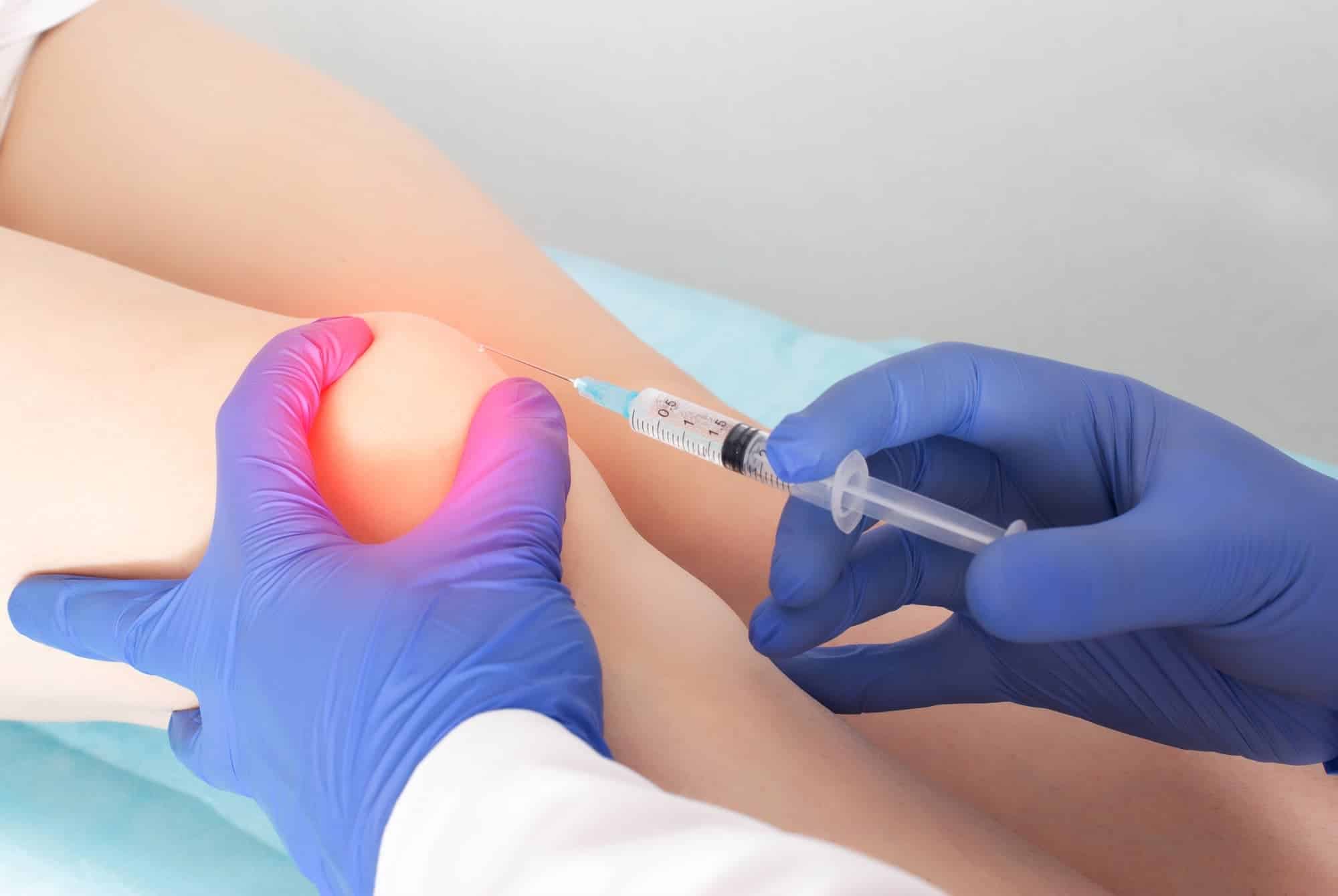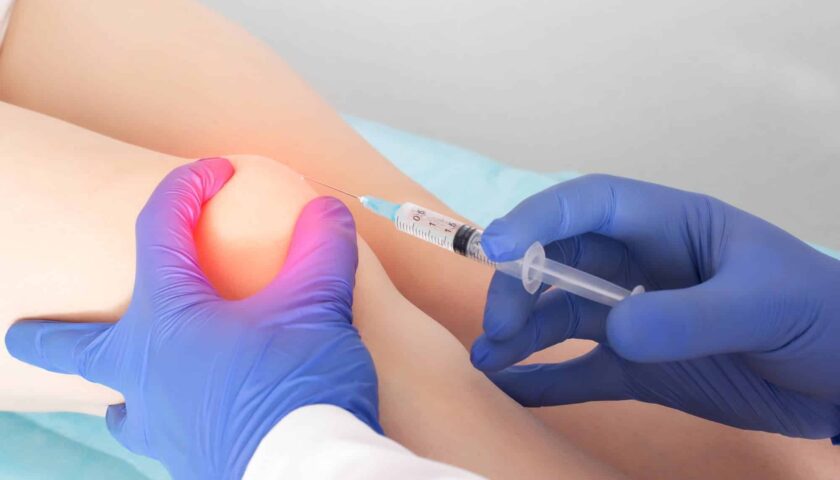
Hyalgan (sodium hyaluronate) injections, also known as viscosupplements or hyaluronic acid injections, are designed to provide symptomatic relief and potentially slow the progression of osteoarthritis.
Osteoarthritis (OA) occurs when the protective cartilage that cushions the ends of bones within a joint breaks down over time, leading to pain, inflammation, and reduced joint function.
The main component of Hyalgan is hyaluronan, a natural substance in the synovial fluid of joints. Hyaluronan is crucial in lubricating and cushioning the joint, allowing smooth and pain-free movement.
What Is Hyalgan?
OA is a joint disease defined by cartilage breakdown, inflammation, and pain. Traditional treatment options, such as NSAIDs and corticosteroid injections, provide symptomatic relief but fail to address the underlying cause of OA. Hyalgan, on the other hand, offers a unique approach by delivering hyaluronan, a naturally occurring component of synovial fluid, directly into the affected joint.
This treatment is typically used in patients with mild to moderate osteoarthritis, especially those who have not responded adequately to conventional therapies. Hyalgan knee injections are the ones most commonly administered, but Hyalgan can also be used for other affected joints, such as the hip or ankle.
It is important to note that while Hyalgan can provide symptomatic relief and improve joint function, it does not reverse the underlying damage to the joint cartilage. Hyalgan is intended to be part of a comprehensive treatment plan for osteoarthritis, which may also include lifestyle modifications, physical therapy, and other interventions to effectively manage the condition and improve the patient’s quality of life.
How Hyalgan Works
Hyaluronan is a glycosaminoglycan that is crucial in joint lubrication and shock absorption. In OA, the concentration of hyaluronan in the synovial fluid decreases, leading to increased friction and joint damage. Hyalgan injections aim to replenish this essential component, restoring joint function and reducing pain.
Hyalgan’s mechanism of action is multifaceted:
- It acts as a lubricant, reducing friction between joint surfaces and mitigating pain during movement.
- It exhibits anti-inflammatory properties, reducing the release of pro-inflammatory mediators within the joint. This anti-inflammatory effect helps to alleviate pain and halt further joint degeneration.
- Hyalgan injections may stimulate endogenous hyaluronan production, further enhancing joint health.
Clinical studies have shown that Hyalgan injections provide symptomatic relief and can also slow the progression of osteoarthritis. By targeting the disease’s underlying pathology, Hyalgan offers a promising therapeutic option for patients with OA.
Hyalgan Patient Selection
While Hyalgan injections have shown efficacy in managing OA, it is essential to carefully consider patient selection to achieve optimal outcomes.
Before administering Hyalgan injections, assessing the patient’s medical history and thoroughly examining the affected joint is crucial. Patient selection criteria may include age, disease severity, joint involvement, and response to previous treatments. Patients with severe OA, joint infections, or skin diseases at the injection site are generally unsuitable candidates for Hyalgan therapy.
Additionally, doctors must take into account patient expectations and lifestyle factors when recommending Hyalgan injections. It is essential to have an open and transparent discussion with the patient, outlining the potential benefits and risks of the treatment.
How To Use Hyalgan Vials
Administering Hyalgan requires precision and adherence to proper technique. Before the procedure, preparing the injection site by disinfecting the area and providing local anesthesia, if necessary, is crucial to minimize patient discomfort.
Hyalgan injections are typically delivered intra-articularly into the affected joint. The dosage and frequency of shots depend on the severity of OA and the manufacturer’s recommendations. Generally, a series of three to five weekly injections are administered, followed by potential maintenance injections as needed.
Before injecting Hyalgan, the doctor must remove synovial fluid from the joint, if present. Once the container with Hyalgan has been opened, the vial must be used immediately. Hyalgan vial is intended for single use only.
During the injection, it is essential to ensure proper aseptic technique to reduce the risk of infection.
Hyalgan Post Care
Following proper aftercare guidelines can contribute to a successful recovery and improved joint health after Hyalgan injections.
While Hyalgan injections are generally well-tolerated, patients should follow specific guidelines to ensure a smooth recovery and achieve the maximum benefits of the treatment. Here are some essential aftercare instructions for patients who have received Hyalgan injections:
- Avoid vigorous activities, particularly those that put excessive stress on the treated joint. Resting the joint for the first 24 to 48 hours can help reduce inflammation and allow the Hyalgan to distribute evenly within the joint.
- Ice application to the injection site for short periods (15-20 minutes) in the first 24 hours can help reduce swelling and alleviate any mild discomfort at the injection site.
- While rest is essential, it is equally important for patients to gradually resume their normal activities under the guidance of their healthcare provider or physical therapist. A gradual increase in activity can help gauge the response to the treatment and prevent overloading the joint.
- In some cases, patients experience mild discomfort or soreness at the injection site or in the treated joint. If the healthcare provider recommends pain management, over-the-counter pain relievers can be used to manage this discomfort.
- Avoid heat and water immersion in the initial days following the injection. Swimming or soaking the treated joint in water should also be avoided for at least 48 hours.
Benefits and Potential Side Effects
Hyalgan injections offer several benefits for patients with osteoarthritis, making them a valuable treatment option in managing this degenerative joint disease. Some of the key benefits of Hyalgan injections include:
- Symptomatic relief from the pain and discomfort associated with osteoarthritis;
- Improved joint function by enhancing the viscoelastic properties of the synovial fluid, allowing for smoother joint movements and increased mobility;
- Non-surgical treatment option for patients with mild to moderate osteoarthritis who prefer to avoid surgery or are unsuitable for surgical interventions;
- Hyalgan injections are minimally invasive and typically require little to no downtime so the patients can continue their regular activities shortly after the procedure;
- While the duration of effectiveness varies from patient to patient, Hyalgan injections can provide relief for up to six months or longer;
- Hyalgan shots are delivered directly into the affected joint, which reduces the risk of systemic side effects compared to oral medications such as nonsteroidal anti-inflammatory drugs (NSAIDs);
- The procedure is complementary to other treatments and can be combined with other treatment modalities, such as physical therapy and exercise, to optimize the overall management of osteoarthritis.
It’s essential to note that the benefits of Hyalgan treatment may vary depending on the patient’s condition and response to the treatment.
Hyalgan viscosupplementation is generally well-tolerated; however, like any medical intervention, it may be associated with some adverse reactions. The most common Hyalgan injection side effects include local reactions at the injection site, such as redness, swelling, and mild pain. These reactions are usually transient and resolve within a few days.
In rare cases, patients may experience systemic adverse reactions, like allergic reactions or anaphylaxis. Therefore, monitoring patients closely during and after the injection is vital, especially after the first few doses. Patients with a history of hypersensitivity to avian proteins or hyaluronan should be approached with extreme caution.
In cases where patients experience persistent or severe adverse reactions, it is essential to discontinue the treatment and explore alternative therapeutic options. Proper patient education about potential side effects and prompt reporting of any unusual symptoms can aid in managing adverse events effectively.
Conclusion
Hyalgan injections represent a valuable and evidence-based treatment option for doctors managing patients with osteoarthritis. Through its unique mechanism of action, Hyalgan not only provides symptomatic relief but also has the potential to slow down disease progression and improve joint function.
Careful patient selection, adherence to proper injection techniques, and vigilant monitoring for adverse events are essential to ensure favorable outcomes and improve the lives of patients with osteoarthritis.
FAQ
What are Hyalgan injections for?
Hyalgan injections, also known as viscosupplements or hyaluronic acid injections, are designed to provide symptomatic relief and potentially slow the progression of osteoarthritis, much like the same results Euflexxa and related products provide.
The goal of Hyalgan knee injections is to supplement the diminished levels of hyaluronan in the affected joint, improving joint lubrication, reducing friction, and relieving pain during movement. Additionally, Hyalgan injections may have anti-inflammatory effects, which can help further alleviate pain and inflammation associated with osteoarthritis.
Is Hyalgan a steroid?
No, Hyalgan is not a steroid. Hyalgan is a type of viscosupplement, a class of injectable treatments for managing osteoarthritis. Specifically, Hyalgan contains a substance called hyaluronan (also known as hyaluronic acid), a naturally occurring component found in the synovial fluid of joints.
How long do Hyalgan injections last?
The duration of effectiveness for Hyalgan injections can vary from patient to patient. Typically, Hyalgan injections provide relief for several months, and some patients may experience benefits for up to six months or longer. However, it’s important to note that individual responses to the treatment can differ based on factors such as the severity of osteoarthritis, the specific joint being treated, the patient’s overall health, and their level of physical activity.
While some patients may find that the pain relief and improvement in joint function last for an extended period, others may require more frequent injections or additional treatment modalities to maintain the benefits. In some cases, doctors may recommend periodic maintenance injections to sustain the positive outcomes of Hyalgan therapy.
References
Huang, T. L., Chang, C. C., Lee, C. H., Chen, S. C., Lai, C. H., & Tsai, C. L. (2011). Intra-articular injections of sodium hyaluronate (Hyalgan®) in osteoarthritis of the knee. a randomized, controlled, double-blind, multicenter trial in the Asian population. BMC musculoskeletal disorders, 12, 221. https://doi.org/10.1186/1471-2474-12-221.
Altman, R. D., & Moskowitz, R. (1998). Intraarticular sodium hyaluronate (Hyalgan) in the treatment of patients with osteoarthritis of the knee: a randomized clinical trial. Hyalgan Study Group. The Journal of rheumatology, 25(11), 2203–2212.
Huskisson, E. C., & Donnelly, S. (1999). Hyaluronic acid in the treatment of osteoarthritis of the knee. Rheumatology (Oxford, England), 38(7), 602–607. https://doi.org/10.1093/rheumatology/38.7.602.
Hamburger MI, Lakhanpal S, Mooar PA, Oster D. Intra-articular hyaluronans: a review of product-specific safety profiles. Semin Arthritis Rheum. 2003;32:296–309. doi: 10.1053/sarh.2002.50008.
Bernstein, S., Hyalgan vs. Synvisc: Differences and Similarities. WebMD. November 2022. https://www.webmd.com/osteoarthritis/osteoarthritis-hyalgan-synvisc.
Injectable aesthetics are popular due to their ability to provide noticeable results with minimal downtime compared to surgical procedures. They are versatile and can be tailored to meet individual aesthetic goals, whether it's enhancing lips, restoring facial volume, or smoothing out wrinkles. However, they should always be administered by qualified professionals to ensure safety and achieve optimal results.
Injectable aesthetics are used to enhance facial features, reduce the signs of aging, and improve overall facial symmetry and appearance.
Key types of injectable aesthetics include:
-
Dermal Fillers: These injectables are used to add volume, fill in wrinkles and folds, and enhance facial contours. They often contain substances like hyaluronic acid, collagen, or calcium hydroxylapatite, which help plump up the skin and smooth out fine lines and wrinkles.
-
Botulinum Toxin (Botox): Botulinum toxin injections temporarily relax facial muscles that cause wrinkles and lines to form. It is commonly used to treat forehead lines, frown lines between the eyebrows, and crow's feet around the eyes.
-
Collagen Stimulators: These injectables stimulate the body's own collagen production, helping to improve skin texture and firmness over time. Examples include poly-L-lactic acid (Sculptra) and calcium hydroxylapatite (Radiesse).
-
Neurotoxin Injections: Besides Botox, other neurotoxins such as Dysport and Xeomin are used similarly to reduce wrinkles and lines.





